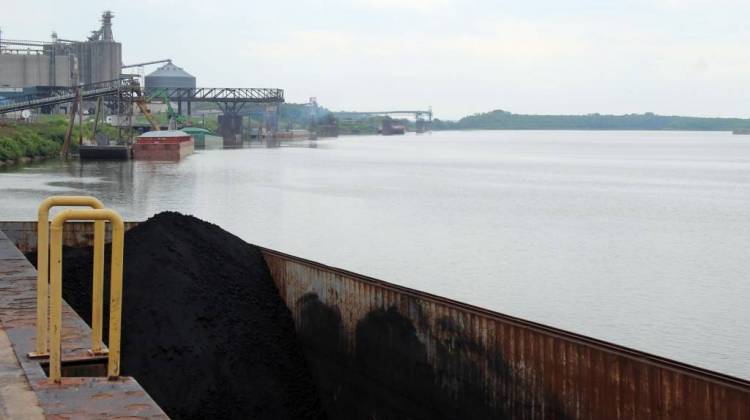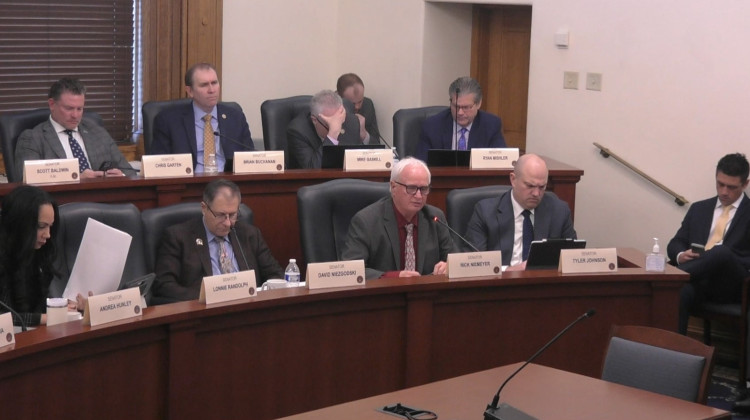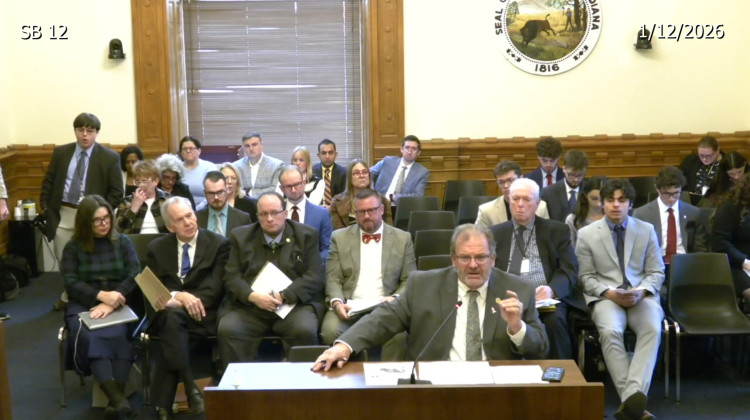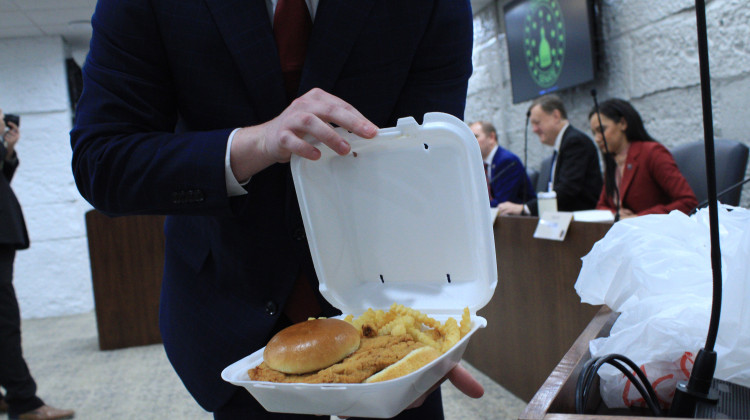
A barge of petcoke, a petroleum byproduct used to make aluminum, waits for offloading at the Port of Indiana-Mt. Vernon, with other barges carrying fertilizer, cement and soybean oil lined up on the Ohio River bank.
Annie Ropeik/IPB News

In our series on the Ports of Indiana, we’ve seen steel and manufacturing hubs on Lake Michigan and the Ohio River. Today, we go to Indiana’s truest river port – Mt. Vernon, outside Evansville. It’s the highest-traffic port in the system, helping move processed grain, coal, and more all around the world. Indiana Public Broadcasting’s Annie Ropeik reports it’s also more susceptible than any other state port to the fallout from shifts in federal policy.
There’s one commodity at the Port of Indiana-Mt. Vernon you won’t find anywhere else in the system. Alliance Coal spokesman Heath Lovell is showing off an 18,000-ton pile of it.
“That’s not a very big pile,” he says, it can be up to 200,000 tons while Alliance waits for barges and demand to take the coal out.
It came from mines in Indiana, Illinois and Kentucky, off trucks and trains that dumped it into pits in the ground. From there, conveyor belts carried it onto this pile, or onto barges on the Ohio River, to ship out to power plants.
“They will take it and they will put it through a pulverizer, and they will turn it into a fine dust, and then they take that and they blow it into a boiler,” Lovell says. “And it’s just like a huge fireball, and then that heats water into steam, and that high-pressure steam turns a turbine and that’s what creates electricity.”
Alliance can handle up to 8 million tons of coal a year at this facility, but federal filings show they aren’t using all of that capacity these days.
The Indiana Utility Regulatory Commission says in its latest annual report that coal made up 20 percent less of Indiana’s fuel mix last year than it did in 2007, replaced largely by cheap natural gas, and to a lesser extent wind.
That’s why Lovell says Alliance’s port space is crucial – using water saves money, he says, and coal needs all the help it can get to be competitive.
“If we’re able to have coal be the cheapest option, then the utilities are buying coal,” he says. “And one of the best ways we can do that is by making sure that we get the transportation cost as low as possible.”
Mt. Vernon is full of commodities tied to volatile markets, including ethanol, soy biodiesel, grains and fertilizer.
Steve O’Nan, vice president of Consolidated Grain and Barge’s soybean processing plant here, says it means they’re closely watching policy changes – from support for biofuels, to the renegotiation of the North American Free Trade Act, or NAFTA, which has heavily benefited many farmers.
“If those borders were closed or there were tariffs that were put into place that were harmful to agriculture, that would have a ripple effect all the way back to Southern Indiana, which we do not want to happen,” O’Nan says.
Port director Phil Wilzbacher says he always points to food to show the impact of the port – and the policies affecting it.
“Relating back to the everyday person who goes to the grocery store and buys a can of Jif peanut butter – you can trace it back here to the soybean oil being produced at this plant,” Wilzbacher says.
But grain and fuels aren’t all Mt. Vernon handles these days. In fact, Wilzbacher says today’s port is likely far beyond what state officials imagined when they built this system 40 years ago.
“The access to the Ohio River – it was primary, it was key. But the rail service is as key. The road access is as important,” he says. “And that is something that gives the port its ability to be successful, is having that connectivity to all three modes.”
Indiana’s other ports have that connectivity too, and they’ve used it to attract something Mt. Vernon is largely missing: a heavy steel or manufacturing base.
Wilzbacher wants that to change.
Mt. Vernon is bigger and has more land open than the other two ports, including a parcel almost the size of all of Burns Harbor. Officials are shopping the space around to site selectors and economic developers. They’ve put the port’s name in on a dozen different projects just this year.
“The manufacturing is one area that I look to an opportunity to promote,” he says. “It’s an ongoing discussion internally of how do we better market ourselves.”
Indiana’s mainstay industries could add some stability at this port, in case political will ever turns against the things that helped it grow.
Read the first two parts of this series, on the Ports of Indiana at Jeffersonville and Burns Harbor.
 DONATE
DONATE







 Support WFYI. We can't do it without you.
Support WFYI. We can't do it without you.